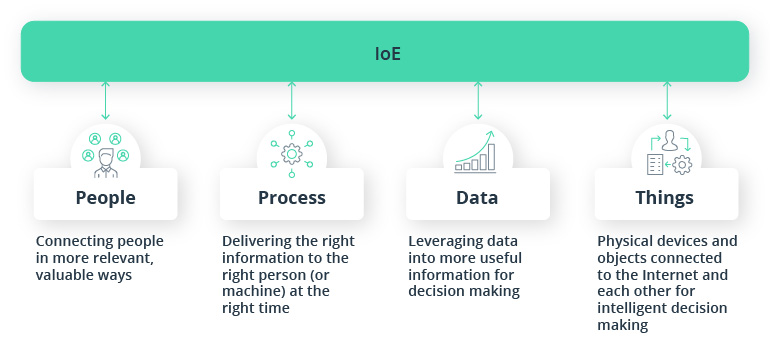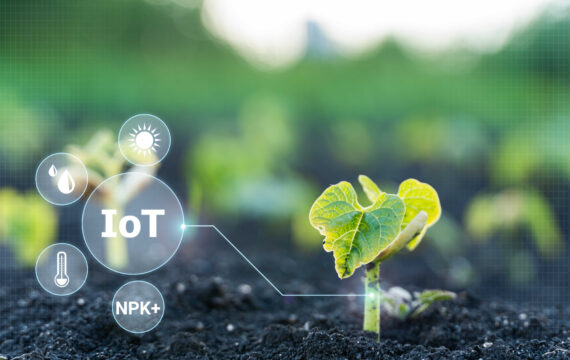The Internet of Things is a relatively young term: it was first mentioned in 1999 and, within the next few years, started making its way to online publications and analytical reports. According to Cisco, IoT was truly born somewhere between 2008 and 2009 when the number of connected devices streaming data to the Internet exceeded the global population of 6.5 billion at the time. As of 2021, this number is much higher and growing at a steady rate (see the illustration below).
Total number of device connections (incl. Non-IoT / 20.0 Bn — expected to grow 13% to 41.2 Bn in 2025)

Source: IoT Analytics
Today, we view the Internet of Things as a global fleet of devices of varying complexity and computing power that capture data, sometimes transform it “on the edge”, and send it to a predefined endpoint or web service for further storage or processing. In essence, IoT devices engage in machine-to-machine (M2M) “conversations” to exchange data and pass it on or use it to adjust their own mode of operation.
So far, the concept has mostly focused on one-way communication of individual devices and feeding sensor readings to the cloud, triggering events or accumulating big data for subsequent analysis. But what if we expanded the functionality of this model and made it considerably more inclusive, autonomous, interconnected, intelligent, and relevant to the immediate needs of their users?
Enter IoE, the Internet of Everything. Yes – everything. In this article you’ll get to know:
- IoT vs IoE: Does the new acronym make a difference?
- IoE essentials
- The Internet of Everything in real-world examples
IoT vs IoE: Does the new acronym make a difference?
So what is the Internet of Everything, really? In a broad sense, it’s an overarching concept that includes the already familiar Internet of Things in its entirety and fuses it with processes and people. It aims to “animate” not only electronic devices, but physical objects as well, and weave them into certain automated processes and usage contexts involving humans.
Traffic systems are often used as a good Internet of Everything example, and there is a reason for that. The automotive industry, with its far-reaching goals of switching to self-driving cars and smart road infrastructures, presents a perfect proving ground for computer vision and LiDAR technologies, real-time onboard AI, highly intensive M2M and P2M communications, connected ecosystems, and other cutting-edge innovations.
The road of the future is a place where self-driving cars are able to read data from the smart road infrastructure (connected cameras, traffic lights) miles ahead and self-optimize their routes to avoid congestion. In case of a traffic accident, a car or, for example, a smart helmet worn by a cyclist, will be able to accurately read the person’s vital signs, quickly assess the damage, contact the nearest hospital, report the exact location and patient’s status, then coordinate the arrival of an ambulance by ordering the traffic control system to clear a lane for it.
In the example above, there is a lot going on between cars and cars, cars and control systems, cars and medical staff, and people and people. All of them form a single “emergency evac” process that is heavily automated and aims to dramatically improve the effectiveness of patient recovery efforts under the most unfavorable traffic conditions. This is exactly what the Internet of Everything aims to achieve.
To sum up, the key difference between IoT and IoE is that the latter is a lot more inclusive and focuses on the creation of autonomous and deeply automated usage scenarios with a high degree of interaction between all IoE constituents.
IoE essentials
Speaking of constituents, IoE clearly wins the Internet of Everything vs. Internet of Things battle.

Source: The Open University
As Cisco, the alleged creator of the term IoE, puts it: “Cisco defines the Internet of Everything (IoE) as the networked connection of people, process, data, and things. The benefit of IoE is derived from the compound impact of connecting people, process, data, and things, and the value this increased connectedness creates as “everything” comes online.”
Therefore, we are dealing with 4 key components.
People
People serve as data sources and key IoE beneficiaries at the same time. First and foremost, it is from people that data is collected from and used for defining optimal outcomes for different scenarios. In some cases, they can even be classified as objects in the IoE paradigm — an entity providing data input for the entire process.
As beneficiaries, people are the ones making final, data-based decisions and reaping the fruits of intelligent automation offered by IoE, the Internet of Everything.
Data
Data is the lifeblood of any IoE system. Streaming in different directions through various network “veins”, it binds everything together and enables the system to work as intended. However, it also poses colossal challenges in terms of connectivity, storage, and processing.
Future IoE systems will likely have thousands upon thousands of fairly complex sensors streaming anything from binary values to hi-res images and footage — and all of this will have to be processed as quickly as possible, demanding a new level of data science and big data skills from system integrators and their technology partners.
Things
In IoE terminology, a thing is any object or device possessing network connectivity and capable of sending sensor readings over the Internet. In fact, even people equipped with certain types of hardware can be considered things in this model.
Yet another important Internet of Everything vs. Internet of Things aspect is that IoT typically views things as conventional connected devices, whereas IoE tends to predict a much wider scope of connected objects. In this model, network connectivity can be everywhere: a pipe can have integrity sensors, a smart water meter can detect water leaks by analyzing deviations from regular water usage patterns, light bulbs can emit light and capture sound at the same time to create a seamless user experience in every room, and so on and so forth.
Process
The process is the cohesive that ties everything together and makes all the effort worthwhile. Without an elaborate process bringing the M2M-P2M-P2P puzzle together, IoE implementation is not possible. Plus, the process always comes first in any IoT/IoE project, since it ultimately defines the means and methods of achieving objectives.
These four staples provide a fairly complete answer to the question “What is the Internet of Everything?”, although some sources also throw “network” into the mix. However, we now know what makes IoE different from IoT, so it’s time we took a look at some Internet of Everything examples.
The Internet of Everything in real-world examples
The scope of potential applications for IoE is virtually limitless with hundreds of feasible scenarios for every industry. Let’s consider just a few of them.
IoE for logistics
The global logistics industry is the perfect candidate for IoE (Internet of Everything). With millions of vehicles and vessels en route to their destinations at any given point of time, and ample room for optimization in every department, using a distributed network of connected sensors and next-generation software seems like an obvious idea for fostering innovation in logistics.
With IoE, process improvements are possible literally everywhere: from warehouses and sorting facilities to (air)ports and service stations. For example, the use of sensor arrays and AI-powered port management software at seaports can lead to multi-million-dollar savings resulting from the optimization of docking and loading/unloading operations, predictive equipment maintenance, and automation of warehouse processes.
IoE for healthcare
Modern healthcare is another area where the implementation of properly working innovative IoE scenarios can really have a huge impact and save lives. As mentioned earlier in the text, emergency response units at hospitals can be connected to traffic management platforms for fast and hassle-free transfer of patients to hospitals. In a similar manner, this kind of automation can be applied to surgery rooms, intensive care units, medical labs, and so on.
On the consumer side of things, IoE can be successfully used for home care, assisted living facilities, and personal healthcare/fitness systems that may include intelligent wearables, connected kitchen appliances, training hardware, and grocery shopping applications. In this example, every component of the “fitness” process will exchange data with others and convey data-based conclusions to the user.
IoE for supply chain management
The term “IoT” was once coined for a meeting on supply chain management and logistics, so there is absolutely no doubt that its successor, IoE, will be a welcome addition to any supply management system of the future. This is especially true for special types of supply chains dealing with particular types of cargo — for instance, cold supply chains for temperature-sensitive food products, medical supplies, and chemicals.
Implementation of IoE elements into supply chain management solutions will help streamline the majority of processes, minimize operational delays, offer clients the visibility they look for when ordering shipping services, align supply and demand in a fully automatic mode and, ultimately, keep the vending machine on your floor always full of the snacks that are 1) popular with people on the floor, 2) are right for you based on recommendations from your IoE healthcare system.
IoE for intelligent traffic control
As mentioned earlier in the article, the entire IoE paradigm is perfect for breathing life and intelligence into the road infrastructure. With various components of the road talking to each other, vehicles, and road services at the same time, the average speed is likely to increase while the number of accidents will go down, as powerful AI/ML algorithms are used for intelligent traffic management.
Combined with the steadily growing number of autopilot-enabled electrical vehicles with outstanding 5G network connectivity, such Internet of Everything implementations can become the most impressive and effective projects of this type.
IoE for smart homes
Smart home systems are where IoT originally started trending as a concept and a technology. Today, with thousands of home automation products on the market, turning homes into IoE ecosystems is easier than ever if you have the right IoT skills and expertise. A typical American household already has one or two voice assistants, a smart doorbell, a connected thermostat, and possibly an entire home automation kit.
With so much hardware already in place, it’s just a matter of time before the emergence of more advanced IoT/IoE cloud platforms and affordable IoT sensors that will be strategically placed on power lines, pipes, fences, and other critical locations of a modern home.
The bottom line
As you can see, IoE is not a futuristic term, but simply an extension of IoT that now includes more actors and more interplay between them. If done right, properly designed and implemented IoE solutions will be able to produce results that will be almost indistinguishable from magic — or, at least, some of your favorite sci-fi movies.
The good news is that we already have nearly everything necessary to make it happen. The bad news is that massive IoE implementation projects may require equally massive investments in infrastructure, so the moment of truth will come when the cost of IoT components, the availability of 5G+ networks, and the readiness of corresponding infrastructures eventually align at an optimal level.
Reach out to our experts and learn much more about how you can initiate or accelerate the creation of intelligent, IoT/IoE-based ecosystems that provide customers with a completely new level of everyday comfort of doing business, full visibility of the condition and location of their cargo, and everything else needed for data-driven decision-making.



